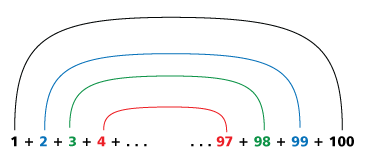By Jane M. Wilburne, Posted October 10, 2014 –
 I love the story of Carl Friedrich Gauss—who, as an elementary student in the late 1700s, amazed his teacher with how quickly he found the sum of the integers from 1 to 100 to be 5,050. Gauss recognized he had fifty pairs of numbers when he added the first and last number in the series, the second and second-last number in the series, and so on. For example: (1 + 100), (2 + 99), (3 + 98), . . . , and each pair has a sum of 101.
I love the story of Carl Friedrich Gauss—who, as an elementary student in the late 1700s, amazed his teacher with how quickly he found the sum of the integers from 1 to 100 to be 5,050. Gauss recognized he had fifty pairs of numbers when he added the first and last number in the series, the second and second-last number in the series, and so on. For example: (1 + 100), (2 + 99), (3 + 98), . . . , and each pair has a sum of 101.

50 pairs × 101 (the sum of each pair) = 5,050.
Another way to represent the problem could be to list the integers from 1 to 100 and write the same list in reverse order below the first list. 
This gives us 100 addends of 101 for 10,100. Because the list of numbers from 1 to 100 was doubled, we need to divide the total by 2, giving us a sum of 5,050.
This representation of the way Gauss solved the problem may help students explore the connection to the algebraic generalized form for finding the sum of a series of consecutive numbers: n(n + 1)/2.
Problems that involve the sum of a series of integers can be adapted for different elementary grade levels.
Students in the primary grades can explore ways to find the sum of the first five or ten counting numbers. Challenge older elementary students to find the sum of the first twenty or thirty counting numbers. What properties of operations might they use to help them find the sum? What strategies might they use to find the sum? What manipulatives would be best to use to help students find the sum? How can teachers facilitate students’ learning to help them make connections to Gauss’s approach without directly showing them his strategy? Please share your ideas and strategies as well as samples of how your students have found the sums.
Let’s change the problem to find the sum of a series of even or odd numbers. What is the sum of the first 20 even numbers? What is the sum of the first 30 odd numbers? What is the sum of the first 100 odd numbers?
I have found that students often misinterpret these problems. For example, some students find the sum of the even numbers up to 20 instead of the sum of the first 20 even numbers. Problems such as these can engage students in the Standards for Mathematical Practice (SMP) (CCSSI 2010), such as “Attend to precision” (SMP 6) and “Make sense of problems (SMP 1).
For Grade 6 students, opportunities to explore other questions exist, such as the following:
- What is the sum of the integers from –10 to +10?
- What is the sum of the series of integers from 24 to 78?
What extensions related to finding the sum of an arithmetic series have you used with your students? Have fun sharing The Story of Gauss task with them. We look forward to your input. NCTM members are welcome to log in and add comments. Comments can also be Tweeted to @TCM_at_NCTM using the hashtag #TCMtalk. Comments can also be emailed to [email protected].
 Jane M. Wilburne is an associate professor of mathematics education at Penn State Harrisburg. She teaches content and methods courses for both elementary and secondary mathematics teachers as well as graduate mathematics education courses. She is a co-author of Cowboys Count, Monkeys Measure, and Princesses Problem Solve:Building Early Math Skills Through Storybooks (Brookes Publishing 2011) and has published numerous manuscripts in Teaching Children Mathematics, among other journals. Jane began serving as a member of the TeachingChildren Mathematics Editorial Panel in May 2014, and her term will continue through April 2017.
Jane M. Wilburne is an associate professor of mathematics education at Penn State Harrisburg. She teaches content and methods courses for both elementary and secondary mathematics teachers as well as graduate mathematics education courses. She is a co-author of Cowboys Count, Monkeys Measure, and Princesses Problem Solve:Building Early Math Skills Through Storybooks (Brookes Publishing 2011) and has published numerous manuscripts in Teaching Children Mathematics, among other journals. Jane began serving as a member of the TeachingChildren Mathematics Editorial Panel in May 2014, and her term will continue through April 2017.